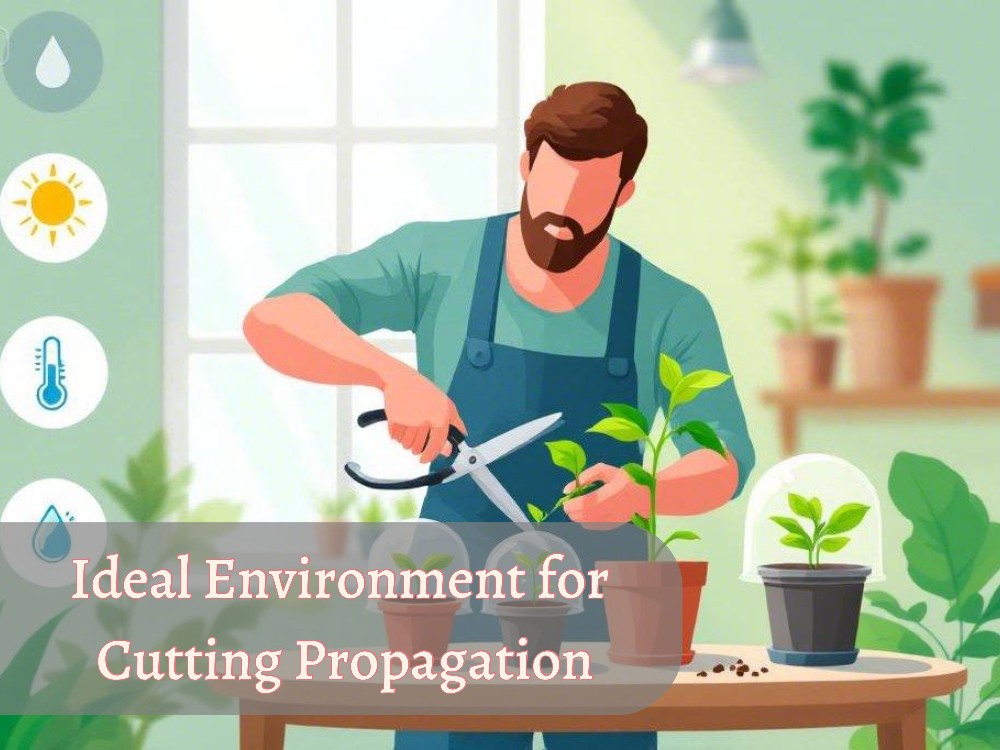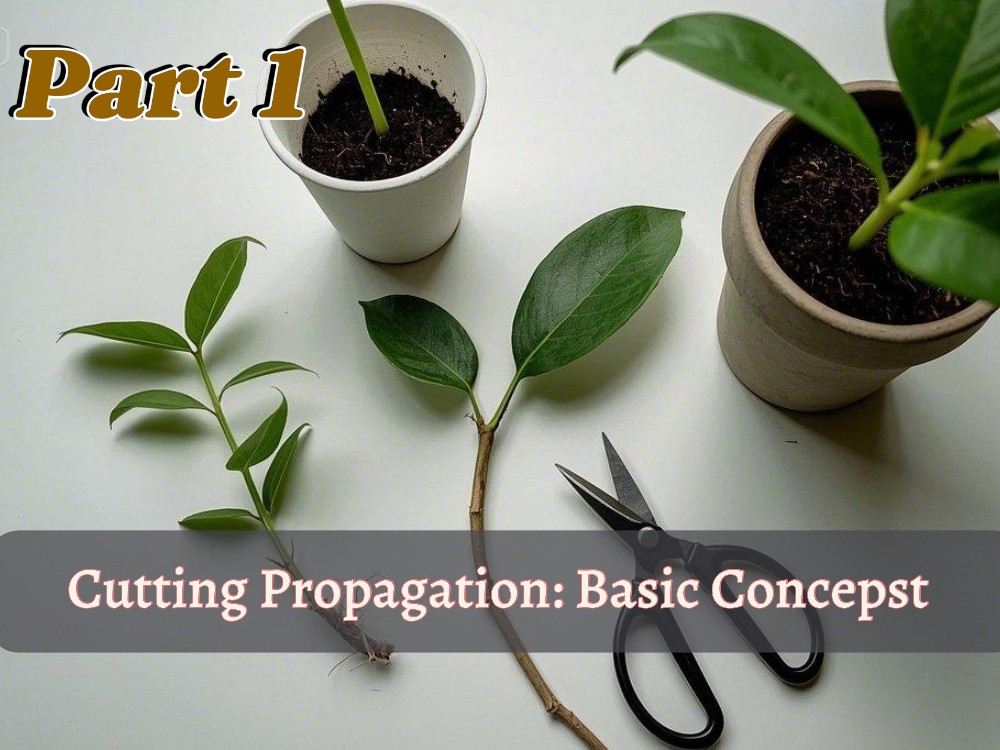Propagation is the best strategy for reproducing plants in the garden. In this process, you grow new generations of your plants, whether through seeds, cuttings, or some other method. But which material and tools do you need?
Let’s explore the propagation process and the material list required in all propagation methods, such as stem cutting, division, and layering.
Key Materials for Plant Propagation
Growing Medium
To grow plants, you first need a suited growing medium. It is the material your plants grow in. For seed propagation, you need a light, well-draining soil. Compost and coco coir are also better mediums.
If you are taking stem cuttings, you can use perlite or sand as a growing medium, as it helps the roots develop: see details about ideal conditions for cutting propagation.
Containers
Containers are also essential for propagation. Small pots, seed trays, or plastic containers are best, but ensure they have drainage holes to prevent waterlogging.
If you are propagating from seeds, shallow trays are best to allow the seeds to germinate properly.
Cutting Tools
Cut the cuttings cleanly and effectively, using sharp scissors or pruning shears to avoid damaging the plant.
Give the cuttings a clean and even cut so they can grow properly. Both steps are crucial in overall propagation.
Rooting Hormones
If you want your cuttings to root quickly, it can be helpful to use a rooting hormone.
This gel or powder is applied to the base of the cutting to help it develop roots rapidly. Rooting hormones is optional but can be helpful for beginners.
Watering Tools
Watering tools are also essential, especially if you need to maintain humidity. You can use a spray bottle or watering mister, which ensures gentle and even watering so the cuttings do not get too much water.
You Must Have Following Materials for Different Propagation
Propagation has several types, such as cutting, division, and layering, so I am explaining the materials list whether you are targeting stem cutting, division, or any other propagation method.
Material List for Stem Cutting
- Sharp pruning shears
- Healthy plant stem (with leaves)
- Rooting hormone (optional)
- Well-draining potting mix
- Small pots or containers
- Plastic bag or plastic wrap
Material List for Leaf Cutting
- Healthy leaves
- Sharp scissors or knife
- Rooting hormone (optional)
- Shallow pots or trays with well-draining soil
- Clear plastic cover or humidity dome
- Misting bottle
Material List for Root Cutting
- Mature plant with strong roots
- Sharp knife or scissors
- Rooting hormone (optional)
- Well-draining soil or potting mix
- Small pots or containers
- Plastic bag or plastic wrap
Discover part 1: What is cutting propagation: Basic concepts Part 2: cutting types
Material List for Seed Propagation
- High-quality seeds
- Seed-starting mix
- Seed trays or small pots
- Plastic cover or humidity dome
- Watering can or misting bottle
- Grow lights (if indoors)
- Plant labels
Material List for Layering
- Healthy stem or branch of the parent plant
- Sharp knife or pruners
- Rooting hormone (optional)
- Peg or wire to secure the stem
- Well-draining soil or container
- Plastic wrap or plastic bag
Discover Layering Propagation!
Material List for Division
- Mature plant with multiple clumps or bulbs
- Sharp garden knife or shears
- Well-draining soil or potting mix
- New pots or garden space for replanting
- Watering can or hose
- Compost or organic matter (optional)
The above propagation method is general and commonly used in gardening. Additionally, if you are a beginner and want to know about another specific propagation method, you can contact me freely!
Choosing Healthy and Clean Plant Materials
When you propagate plants, not only the plant material itself but also your tools and environment play a vital role in the cleanliness of your process.
Choosing clean and healthy plant materials and reliable tools is crucial for healthy growth and strong roots.
Here are some tips on how to select the right plant material and tools for propagation:
1. Healthy and Clean Plant Material
- Choose disease-free plants: Your chosen plant materials should be free from pests, molds, or diseases. If the plant is damaged or diseased, it can affect the success of the propagation.
- Harvest at the Right Growth Stage: Every propagation technique requires different ideal materials. Choose stems or leaves that are in active growth but not too soft or old for cuttings.
- Use clean and sterile tools: Always use sharp, clean tools, such as scissors, knives, or pruners, when cutting plant material. Sterilize the tools before using them to prevent the transfer of bacteria or fungi that could harm the plant.
- Choose strong and vibrant material: For cuttings or divisions, choose stems, leaves, or roots that are strong and vibrant. Avoid material that is weak, dry, or damaged.
2. Essential propagation tools
- Clean pots or containers: Always utilize clean pots or containers to store plant material, as dirty containers can introduce pathogens that may inhibit the rooting process.
- Sterile propagation medium: Whether you are using soil, sand, or water, make sure the propagation medium is sterile and does not harbor harmful bacteria or fungi.
- Humidity domes or plastic covers: These tools maintain humidity around your propagation plants, creating an ideal environment for rooting. Keep the cover clean and allow some air circulation to prevent mold from forming.
- Rooting hormone (optional): Plant materials should be clean and healthy when using rooting hormone so the roots can take root more quickly.
- Watering tools: Clean watering cans or spray bottles are essential to keep your propagation medium moist, but avoid overwatering. Dirty watering cans can cause root rot.
3. Choose the right tools for the propagation method
- For stem cuttings: Sharp scissors or pruning shears are critical to precise and clean cuts so that the cuttings are healthy and free of damage.
- For layering: If you are propagating by layering, use a clean stake or support to support the stem until it is rooted.
- For division: Using a clean spade or garden fork makes it easier to divide the roots without damaging them, which is essential for the division method.
Basic and Essential Tips You Need to Follow While Propagating
1. The Importance of Sterilizing Tools
Most gardeners use their tools sparingly, but sterilizing them is necessary. When propagating, if your tools have any bacteria or fungus on them, it can pose a threat.
The easy solution is to clean your tools with rubbing alcohol and rinse them with warm water.
2. Using Rooting Hormones
A pro tip is to use rooting hormones. These hormones (typically available in powder or gel form) help cuttings develop roots more quickly.
If you have previously planted a cutting directly in soil and it has not rotted, you can try again with rooting hormones.
3. Smart Use of Humidity Dome
Humidity control is necessary when propagating plant cuttings. But here is a unique method: Cut off the bottom of a plastic bottle and place it like a dome over the cutting.
This way, the plant gets more moisture, and at the same time, it works better to develop its roots.
4. Adjust the light over time
Direct sunlight is not necessary for every cutting. Your plant needs indirect light, but have you ever thought that changing the light can also be a trick? As your plant starts to grow, its light needs also change.
You should adjust your cutting to the light conditions according to its development. It will help the plant’s roots adapt better.
5. Use light for the rooting process.
It is also noteworthy to plant cuttings to receive light and heat. Here’s a simple trick: Keep your cuttings in a warm place, such as a heating pad, or place them in the warmest part of your kitchen (near the stove).
This extra heat helps the roots grow faster, and you’ll get quicker results.
6. Choose plants that are climate-appropriate for propagation
Each plant has its own climate requirements. For example, some plants grow best in tropical climates, while others do better in cooler temperatures.
Here you can also check plant ability for cutting propagation.
You should adjust your propagation technique to the plants’ specific climate requirements. This unique tip will help you keep your plants in optimal growing conditions.
Also, you need to examine how plant growth traits influence by environmental factors.
7. Avoid overwatering your cuttings
Overwatering is also a common problem which causes moss to rot. When you propagate your cuttings, too much water can cause the roots to rot.
Therefore, keep the soil moist but not waterlogged. This tip will ensure healthy plant growth and save you from failure.
8. The secret to regular observation and patience
It is a unique tip that most gardeners ignore. You should monitor your propagation process regularly. If you see changes in the cuttings, you can take timely action.
And the most needed thing is patience! Give your plants time to grow.
Final Thoughts: Materials & Safety Needed In Plant Propagation Process
Propagation is an effective way to develop new plants quickly. These techniques are necessary when plants do not grow naturally from seeds or parts or when their specific traits are required for preservation.
Whether new to gardening or an experienced gardener, propagating plants can be fun and rewarding.
Each plant requires a slightly different approach, and following the basic principles of propagation we have discussed is very easy and effective.






